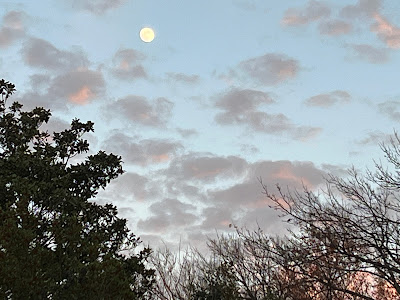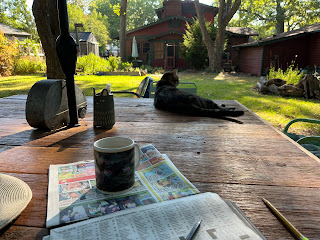Note: I wrote most of this a month ago, but got distracted by the holiday season and some dismal weather. It was originally meant to be the first in a two-part series (but don't hold your breath), this one subtitled "A Nostalgic, Mostly Random, Catalogue of a Life's Worth of Trees." It has morphed into a grateful farewell to 2023.
 |
| Brief glimpses of the sky in late summer |
The most important difference between desert rats, like me and my father, and the rest of humanity, is that we easily become oppressed by voluminous masses of trees.
For the tree-shy among us, vast volumes of sky are preferable to endless forests. It seems somewhat ironic, therefore, that most of my life has been spent in subtropical forests (Taiwan) and blackland prairie (north central Texas) that's been transformed into suburbs with tree-lined boulevards and back yards full of native hackberry, pecan, and burr oak, as well as bird-planted mulberry, chinaberry, catalpa, and privet--in addition to developer-planted Callery and Bradford pears. The gradual overtaking of native grasslands by Eastern red cedar trees is another kind of problem, because these cedars are native to Oklahoma, but are becoming a plague across Nebraska and other prairie states.
Finding open sky over our little half-acre is almost impossible for three quarters of the year. One of the most enjoyable aspects of autumn is the gradual opening of our rather dense canopy (especially after having had the Tree-saver people out for some serious pruning to prevent winter damage due to dropped branches), and the welcome expanses of sun that spill in with the also-welcome cooler weather.
The back yard is populated by five very large pecans, one of which dropped an enormous branch after a wet spell that had followed a longer dry one. This is what prompted the latest thinning, because our lot also harbors four more pecans, four oak varieties, a sweet gum, and a few stray bird-planted specimens of catalpa, cedar, redbud, and a large tree-bush that looks like a viburnum in bloom but has leathery, serrated leaves like a holly (I've lately found out that it's an English Holly). And then there are the yaupon holly shrubs that hide a good deal of the house from the street, and shade the living room from the eastern morning sun in summer. A ten-year old chinaberry had to be cut down this year (leaving lots of lumber for various uses), as did a Callery pear and a mulberry. I'm hoping to use the newly vacant space to plant a fruit tree near the compost bins, but haven't decided whether battling the pear-eating squirrels would be worth the effort. There are two pears on the southern border of the property, but we haven't had a crop in years because the squirrels denude them almost as soon as they flower. Maybe something pretty, like a vitex chaste tree, which always do well around here, and are natives.
 |
| The aftermath. |
After recently reading Kendra Atleework's moving memoir of growing up in the Owens Valley, Miracle Country, I realized that there is a small connection between there and here: the Liquidambar styraciflua growing in front of my house, the sweet gum, is the same species as one that grows in Atleework's yard in Bishop.
When my son was two years old, my father and stepmother visited us on Long Island, where we lived in a lakeside cabin on Long Pond (better known as Lake Panamoka). It was there that I first hear the "too many trees" remark as a reason why my dad hadn't ever been interested in living in the east. After a final Air Force stint in Hawaii, he had retired to an acre or so in Porterville, California (on the other side of the Sierras from where we both were born), which sported a couple of fruit trees and a pollarded mulberry, but not much else. A magnificent oak sheltered grazing cows on the other side of the back fence, but it was far enough away to not count as too many.
I do remember that when I was a small child, visiting my father's parents in the Owens River Valley, there were a few fruit trees and a gorgeous (and prolific) walnut tree in the back yard of the house provided by the Los Angeles Department of Water and Power electrical plant at Cottonwood. The infamous aqueduct across from the desiccating bed of Owens Lake snaked by the house and the plant, where my grandfather worked until the end of his life. After he died, though, my grandmother moved to town (Lone Pine, where I was born). There her tiny back yard was graced with a honey locust and a catalpa. Her mother had loved the big, fragrant, orchidy flowers of catalpas, which is what prompted me to let one grow next to my driveway in McKinney. It had to be cut down during the recent trimming because it was dying, but its replacement is already about six feet tall, standing in the middle of an iris bed. In the front yard of my grandmother's house two very large cottonwoods grew, but eventually died as the city of Los Angeles got stingier and stingier with the water it was diverting from the Owens River.
During the five years my father was stationed in Taiwan, we lived in five different houses, three of which were located on Yang Ming Shan (Grass Mountain), and, if they survived the inexorable and exponential growth of Taipei city in the '60s and '70s, are now part of the National Park. The first and last houses were in Taipei proper, but I only remember the Jacaranda tree that grew inside the stuccoed brick wall that surrounded the first house. It was huge, and bloomed luxuriantly with purple blossoms the first spring/summer we were there. It was also great for climbing. The Yang Ming Shan houses, however, were mostly nestled into clearings in the jungle, and overlooked terraced rice paddies all the way down into the valley below, or a waterfall into a sulphur river. The last mountain house had a pomelo tree at the top of the entry steps. Although one has to work at it, peeling the one-inch rind off the fruit is well worth the time and effort it takes to reach the slices of mild grape-fruity sweetness. Sadly, the quality of pomelo one can get here in the States doesn't begin to approach that childhood memory.
It's probably the case that my ambivalent relationship with trees developed only after I'd spent my early adult life in palm tree dominated Southern California, and began to see my home town as my real home--even after I had moved permanently to Texas, finally met a compatible husband, and finished raising my kids. Now when we travel, it's always west, through the deserts and mountains of the Basin and Range. So far we've hauled several dogs and a cat back and forth three different times, pulling a caravan (first an imitation Shasta Airflyte, and then a larger, more animal-compatible retro style canned ham) behind our Jeeps, spending as much time as we can trying to soak up the atmosphere of sand and sky and clear air before we head back to a place we're finding really difficult to imagine leaving permanently.
We've been here in north Texas together for over thirty-five years, but often muse about moving west for good. At best, however, we'll probably manage at least one more caravan trip back. We've lavished an enormous amount of labor and love on the house, the garden, and--yes--the trees. Whether or not there are too many of them. They do help me mark the seasons, though, and here are some early winter shots of skeletal trees and the surprising skies they occasionally frame (the large magnolia on the left of the first photo belongs to my neighbor):
 |
| Moonrise just before the Full Wolf Moon, 25 December. |
 |
| Facing west this morning, toward the Wolf Moon's waning gibbous remains. |
 |
| Sunrise on New Year's Eve. |
 |
| A bit of year-end sky drama from the north, just after sunrise this morning. |
One of the reasons I enjoy Skywatch Friday is that it inspires me focus on what's overhead, which often presents surprisingly beautiful photo opportunities. And the sheer number of possible dramatic meteorological displays available to me serves to remind me of why we continue to live here and why we probably will never leave. The property may measure only a half acre, but it's our little bit of refuge in a world now tormented by yet another war and ever more destruction.























